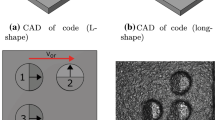Abstract
The traceability of all elements within a metal manufacturing industry constitutes a critical challenge in the digitalization of industrial processes. In this context, the labeling of these elements, coupled with optical character recognition (OCR), plays a significant role. Therefore, in this paper, it is accomplished this challenge by applying three pre-trained deep learning OCR models such as Pytesseract, EasyOCR and KerasOCR to a dataset of images featuring labels with corresponding alphanumeric codes. The performance of these OCR engines has been evaluated using various types of input images, to which preprocessing techniques have been applied to enhance their quality and the legibility of the text contained within. The implementation of these models produced successful results, presenting a viable solution to improve the efficiency and accessibility of information retrieval processes within the industry.
Access this chapter
Tax calculation will be finalised at checkout
Purchases are for personal use only
Similar content being viewed by others
References
An, Q., Shi, Y.: Does enterprise digitization reduce carbon emissions? Evidence from China. Chin. J. Popul. Resour. Environ. 21(4), 219–230 (2023). https://doi.org/10.1016/j.cjpre.2023.11.003. https://www.sciencedirect.com/science/article/pii/S2325426223000475
Beliatis, M.J., Jensen, K., Ellegaard, L., Aagaard, A., Presser, M.: Next generation industrial IoT digitalization for traceability in metal manufacturing industry: a case study of industry 4.0. Electronics 10(5), 628 (2021)
Charfeddine, L., Umlai, M.: ICT sector, digitization and environmental sustainability: a systematic review of the literature from 2000 to 2022. Renew. Sustain. Energy Rev. 184, 113482 (2023). https://doi.org/10.1016/j.rser.2023.113482. https://www.sciencedirect.com/science/article/pii/S1364032123003398
Cho, S., Lee, J.M., Woo, J.H.: Development of production planning system for shipbuilding using component-based development framework. Int. J. Naval Archit. Ocean Eng. 13, 405–430 (2021). https://doi.org/10.1016/j.ijnaoe.2021.05.001. https://www.sciencedirect.com/science/article/pii/S2092678221000261
Diaz, R., Smith, K., Bertagna, S., Bucci, V.: Digital transformation, applications, and vulnerabilities in maritime and shipbuilding ecosystems. Procedia Comput. Sci. 217, 1396–1405 (2023). https://doi.org/10.1016/j.procs.2022.12.338. https://www.sciencedirect.com/science/article/pii/S1877050922024231, 4th International Conference on Industry 4.0 and Smart Manufacturing
Grauer, Z.: Systems and traceability of quality systems. American Laboratory, p. 15 (2003)
Ignasius, A., Chandra, J.C., Oscadinata, R., Suhartono, D.: Image pre-processing effect on OCR’s performance for image conversion to braille unicode. Procedia Comput. Sci. 227, 922–931 (2023). https://doi.org/10.1016/j.procs.2023.10.599, 8th International Conference on Computer Science and Computational Intelligence (ICCSCI 2023)
Li, C., et al.: PyCinemetrics: computational film studies tool based on deep learning and PySide2. SoftwareX 26, 101686 (2024). https://doi.org/10.1016/j.softx.2024.101686
Marti, L., Puertas, R.: Analysis of European competitiveness based on its innovative capacity and digitalization level. Technol. Soc. 72, 102206 (2023). https://doi.org/10.1016/j.techsoc.2023.102206. https://www.sciencedirect.com/science/article/pii/S0160791X23000118
Martínez-Rojas, A., Jiménez-Ramírez, A., Enríquez, J., Reijers, H.: A screenshot-based task mining framework for disclosing the drivers behind variable human actions. Inf. Syst. 121, 102340 (2024). https://doi.org/10.1016/j.is.2023.102340
Mickeviciene, R.: Global competition in shipbuilding: trends and challenges for Europe. The Economic Geography of Globalization, pp. 201–222 (2011)
Patel, C., Patel, A., Patel, D.: Optical character recognition by open source OCR tool tesseract: a case study. Int. J. Comput. Appl. 55, 50–56 (2012). https://doi.org/10.5120/8794-2784
Salonen, A., Gabrielsson, M., Al-Obaidi, Z.: Systems sales as a competitive response to the Asian challenge: case of a global ship power supplier. Ind. Mark. Manage. 35(6), 740–750 (2006). https://doi.org/10.1016/j.indmarman.2005.06.008. https://www.sciencedirect.com/science/article/pii/S001985010500101X
Schönfelder, P., Stebel, F., Andreou, N., König, M.: Deep learning-based text detection and recognition on architectural floor plans. Autom. Constr. 157, 105156 (2024). https://doi.org/10.1016/j.autcon.2023.105156
Smith, R.: An overview of the tesseract OCR engine, vol. 2, pp. 629–633 (2007). https://doi.org/10.1109/ICDAR.2007.4376991
Sporici, D., Cuşnir, E., Boiangiu, C.A.: Improving the accuracy of tesseract 4.0 OCR engine using convolution-based preprocessing. Symmetry 12(5), 715 (2020)
Sugiyono, A.Y., Adrio, K., Tanuwijaya, K., Suryaningrum, K.M.: Extracting information from vehicle registration plate using OCR tesseract. Procedia Comput. Sci. 227, 932–938 (2023). https://doi.org/10.1016/j.procs.2023.10.600, 8th International Conference on Computer Science and Computational Intelligence (ICCSCI 2023)
Yi, Z., et al.: Intelligent initial model and case design analysis of smart factory for shipyard in china. Eng. Appl. Artif. Intell. 123, 106426 (2023). https://doi.org/10.1016/j.engappai.2023.106426. https://www.sciencedirect.com/science/article/pii/S0952197623006103
Acknowledgments
This work has been supported by Centro Mixto de Investigación UDC-Navantia (IN853C 2022/01), funded by GAIN (Xunta de Galicia) and ERDF Galicia 2021-2027.
Míriam Timiraos’s research was supported by the “Xunta de Galicia” through grants to industrial PhD (http://gain.xunta.gal/), under the “Doutoramento Industrial 2022” grant with reference: 04_IN606D_2022_ 2692965.
CITIC, as a center accredited for excellence within the Galician University System and a member of the CIGUS Network, receives subsidies from the Department of Education, Science, Universities, and Vocational Training of the Xunta de Galicia. Additionally, it is co-financed by the EU through the FEDER Galicia 2021-27 operational program (Ref. ED431G 2023/01). Xunta de Galicia. Grants for the consolidation and structuring of competitive research units, GPC (ED431B 2023/49).
Author information
Authors and Affiliations
Corresponding author
Editor information
Editors and Affiliations
Rights and permissions
Copyright information
© 2024 The Author(s), under exclusive license to Springer Nature Switzerland AG
About this paper
Cite this paper
Arcano-Bea, P., Timiraos, M., Fariñas, P., Zayas-Gato, F., Calvo-Rolle, J.L., Jove, E. (2024). A Deep Learning-Based OCR System Implementation for Traceability Ensurement in a Metal Manufacturing Workshop. In: Zayas-Gato, F., Díaz-Longueira, A., Casteleiro-Roca, JL., Jove, E. (eds) Distributed Computing and Artificial Intelligence, Special Sessions III - Intelligent Systems Applications, 21st International Conference. DCAI 2024. Lecture Notes in Networks and Systems, vol 1173. Springer, Cham. https://doi.org/10.1007/978-3-031-73910-1_3
Download citation
DOI: https://doi.org/10.1007/978-3-031-73910-1_3
Published:
Publisher Name: Springer, Cham
Print ISBN: 978-3-031-73909-5
Online ISBN: 978-3-031-73910-1
eBook Packages: Intelligent Technologies and RoboticsIntelligent Technologies and Robotics (R0)




